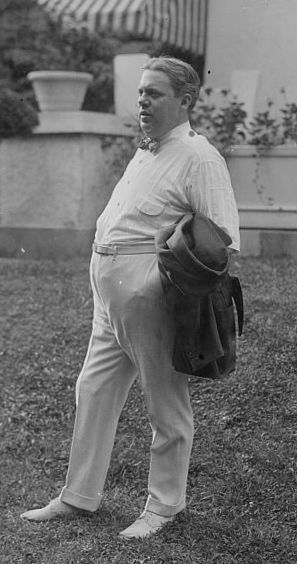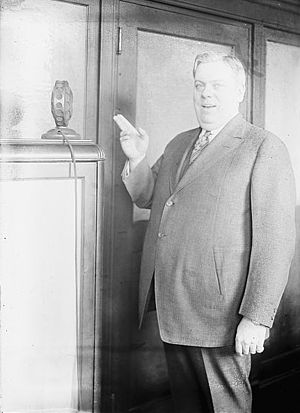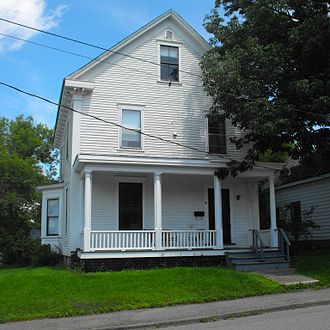Harry Henry McClaskey of St. Stephen
Harry Haley McClaskey was born in St. Stephen on January 15, 1882, to Alfred Alexander McClaskey and Ida May Conners McClaskey. His father who was always referred to as A.A. McClaskey operated a candy and tobacco store in St. Stephen and as a boy Harry worked at the family store. He was not, however, destined to stay long behind the counter of the family business. By the age of 5 it was clear Harry was a musical child prodigy, already making appearances locally and by the age of ten singing on a bigger stage in Saint John where he later moved with his family. Harry performed under the name “Henry Burr” and became perhaps the most well-known tenor of the early 1900s and a pioneer in recording music on cylindrical and phonograph records.
Doug Dougherty, noted St. Stephen historian, tells Harry’s story in his book, St. Stephen-Yesteryear:
HARRY HALEY MCCLASKEY (HENRY BURR)
1882-1941
Harry Haley McClaskey born January 15, 1882, son of A.A. and Ida (Connors) McClaskey in the home now occupied by Mr. and Mrs. Donald Williams, Armstrong Street, St. Stephen, N.B.
He attended the local school and Mount Allison University and studied voice in New York under John Dennis Meahan and Ellen Burr, from whom he took his name. His talent became known very early, making appearances in St. Stephen at the age of 5.
The family moved to Saint John, N.B.. At the age of ten he made his singing debut in Saint John as mascot in the “Bicycle & Athletic Club” singing “Her Eyes Don’t Shine Like Diamonds”. At the age of 13 he was soloist with the Saint John Military Band. While in his teen years he moved to New York and obtained his first church job as a tenor soloist at Grace Methodist Episcopal Church in New York.
As his career progressed he chose the name of Henry Burr and while in his early 20’s he was receiving as much as $1,000.00 for a single concert performance. He developed twin careers: a distinguished church soloist and a recording artist. He was one of the first to record on cylindrical records. He recorded for Victor and Columbia Record Companies, he signed with Edison and pioneered in the experimental stages of phonograph recording. He also recorded under the name of Irving Gillette.
He made an early acquaintance with Alexander Graham Bell and was chosen to sing over the first trans-continental telephone hook-up in history. By 1904 he was established as one of the foremost recording artist of the day, bringing him world fame. His record “Remember” sold over 10 million records; “Good Night Little Girl, Good Night” sold over 3,300,000.
Henry Burr returned often to St. Stephen, giving many concerts. In 1920 he sang at the evening service in the McColl Methodist Church (the church of his boyhood) to an overflowing crowd. He assisted the choir in the singing of the hymns and was heard in two solos accompanied by Miss Elva Nicholson. The choir was augmented by a male quartet composed of W.G. DeWolfe, H.E. Beek, W.A. Hyslop and Verne Love.
In 1939 he joined the radio show “National Barn Dance” as their ballad singer. Minnie Pearl, the comedian was also a member of the show.
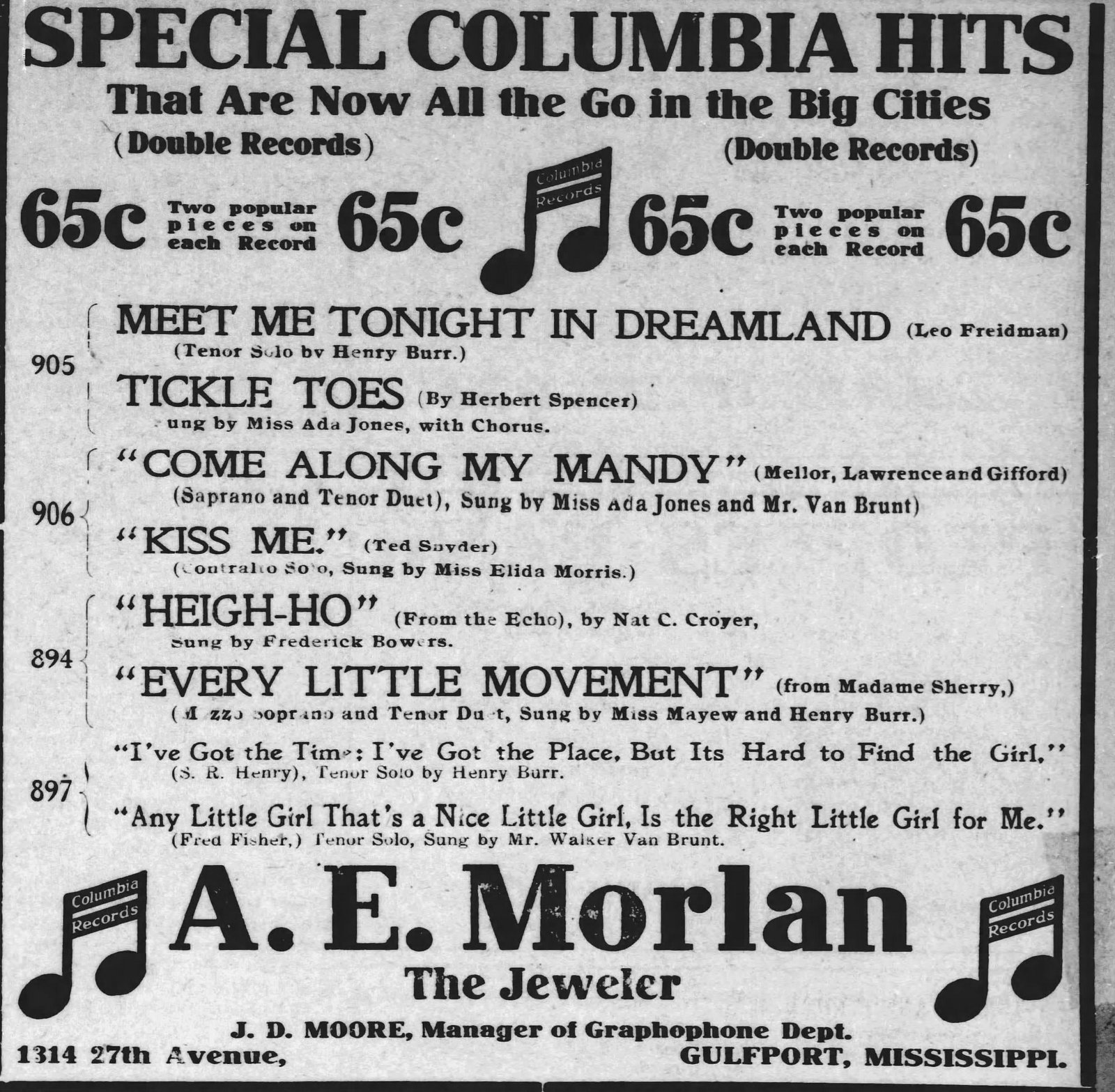
In 1910 Columbia Records was a top recording company. Henry was a star performer.
By 1910 Burr was already a successful recording artist and as Doug Dougherty noted he was able to demand a thousand-dollar fee for a single concert, the equivalent of $33000 today.

1920 Concert Tour
While his recordings were selling well there was still plenty of money to be made on the concert tour where he always received top billing. His quartet, the Henry Burr Quartet, was also very popular.
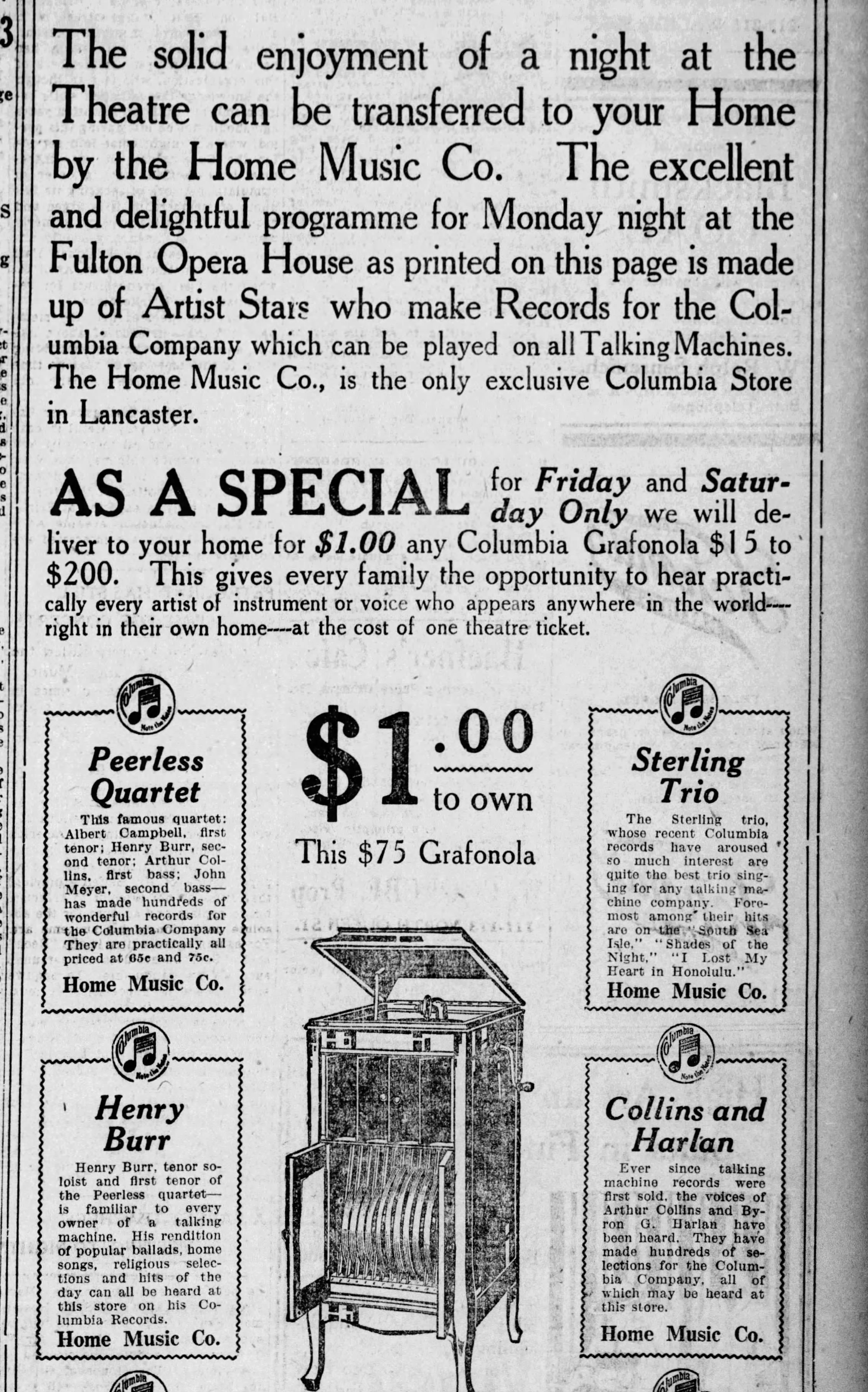
Henry and his Peerless Quartet not only sold records but record players
A search of the newspapers of the era finds Henry much in demand as a concert performer, a recording artist and salesman for companies selling the latest model of the record player which became the center of entertainment in every home. The hand cranked Victor Victrola cost $37.50 in 1920 which was more than the average paycheck for an American in 1920. Still Americans were willing to pay the price for this most wonderful of inventions which seemed to them almost magical.
Henry was a natural fit for radio
Burr was not a man wedded to old technologies. When live concerts found themselves in competition with sound recordings and the phonograph, he followed the newer technologies to the top of his profession. When radio began to supplant both he transformed himself into a radio personality.
Harry Haley McClaskey of St. Stephen became a rich man as Henry Burr. Like many other wealthy Americans, and a few poor ones who found they could buy stocks on margin, he invested heavily in the stock market in the 1920’s only to come a cropper along with millions of others when the stock market crashed in October of 1929. Still his talent allowed him to persevere.
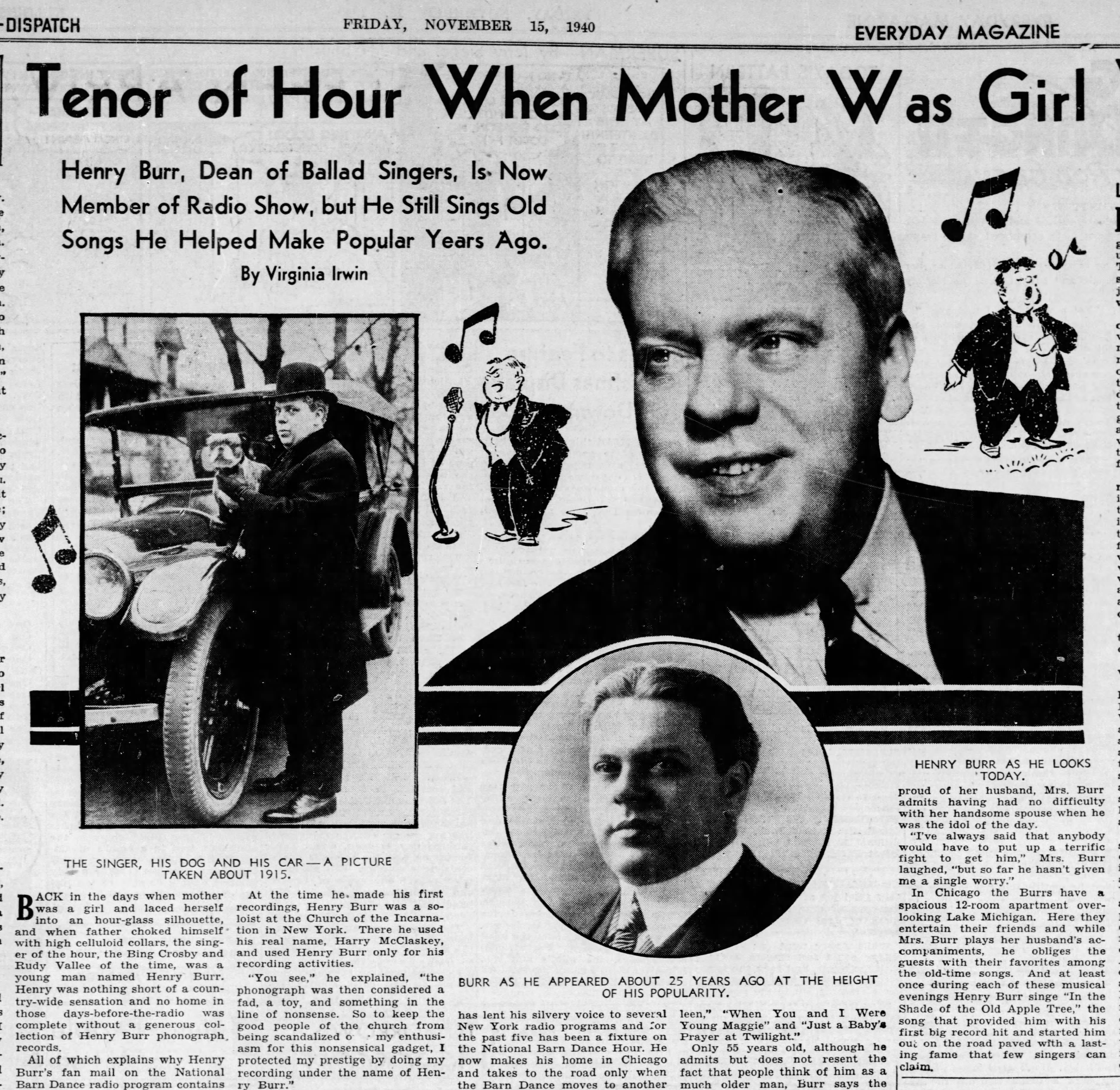
1940 article published in Everyday Magazine
When Henry died a year after the above article was published, many newspapers throughout the United States and Canada published his obituary including this one in the New York Times-
New York Times April 7, 1941
HENRY BURR, NOTED AS BALLARD SINGER
Voice That Thrilled Millions Over Air And On Stage Still Heard On Phonograph
He Dies in Chicago at 59
“In the shade of the old apple tree” one of favorites – made tests with Edison.
Special to the New York Times
Chicago, April 1
Henry Burr Dean of ballad singers died today in his home here after a long illness but the voice which thrilled millions in the years when the gaslight era was giving away to electricity may still be heard on more than 10 million phonograph records. He was 59 years old.
One of his thousands of records “Goodnight Little Girl Goodnight” sold more than 3 million copies. Others included such old time favorites as “In The Shade of the Old Apple Tree” Always Remember” “Just a Baby’s Prayer at Twilight” and “When You and I Were Young, Maggie.”
Burr was known as a star of the concert stage and radio, as well as in his recordings. Born in St. Stephen NB he began singing when only five years old under his original name, Harry McClaskey. While he was vending candy and tobacco for his father he was discovered by Giuseppe Campanari the former Metropolitan Opera baritone, who suggested that he go to New York and study.
There he landed his first job as a tenor in the Grace Methodist Episcopal Church. When he began to make recordings, he took the name of Henry Burr because record making was considered frivolous for an eminent singer.
With the late Thomas Edison Mr. Burr pioneered in the experimental stages of phonograph recording. He was one of the first to record on cylindrical waxings, singing into several horns, each attached to a separate record.
He was credited with making the first transcontinental broadcast. This was long before radio. He sang from New York, and telephone wires carried his voice to diners at a Rotary dinner in California. The diners wore headphones.
In 1920 Mr. Burr turned to radio. At his first broadcast, in Denver he sang into a microphone improvised from a wooden bowl containing an inverted telephone transmitter. The fact that the broadcast was heard in San Francisco made newspaper headlines on the West Coast.
For the last five years Mr. Burr has been the ballad singer of the national barn dance radio program.
He leaves a widow Cecilia. A funeral service will be held here on Wednesday. Burial will take place in Mount Vernon, New York.
Even after his death his recordings remained popular. In 1957 the Hollywood newspaper Variety under a headline “Bing Crosby’s 130,000,000 Disk Sale Makes Him Champ of Modern Era” admits Bing had a long way to go to equal the all time champs- Billy Murray and Henry Burr. While acknowledging Murray had grossed 300,000,000 sales, Variety went on to say:
Crowding Murray was the late Henry Burr who, like his colleague sang solo and in ensemble, and also an assortment of wax works identities. He topped Murray on the number of titles but not in sales. Burr’s 12,000 to 20,000 different tiles are estimated to have sold “only” 240,000,000.
McClaskey Home Armstrong Street St. Stephen
Henry grew up in this house on Armstrong Street in St. Stephen which, when Doug Dougherty wrote his history, was said to belong to Mr. and Mrs. Donald Williams. As Doug Dougherty mentioned he visited occasionally and returned for the funerals of his parents and brother Frank who are all buried in St. Stephen.

